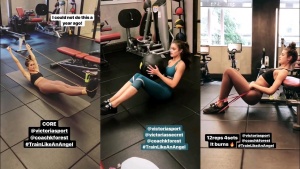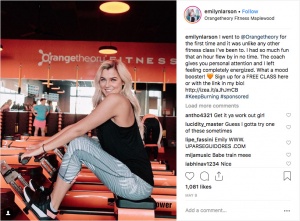Fitness Influencers
== Currently Editing - Morgan Tucker ==
Social media fitness influencers create content that revolves around fitness and health-related topics, such as exercise and nutrition. Their follower counts range from a thousand to millions across multiple different social media platforms, allowing them to reach masses of people with fitness information, pictures, and any other content they link to their account. [1] These influencers not only hold influential power over their followers they have added benefits like free branding, social media platforms paying them for content they post, and commission from companies they work with. Some of the fitness content posted on social media platforms has raised ethical concerns surrounding misinformation, body image, and more. [2][3]
Fitness influencers’ social media content may typically include workout ideas, training tips, motivational advice, information on nutrition, recommendations for dieting plans, and recipes for healthy eating. This content often takes the form of pictures and videos of fitness influencers demonstrating certain exercises, describing workout plans, making their favorite recipes, and showing their toned physique. Popular platforms include Instagram, Youtube, and TikTok.

Contents
Information Accessibility
The cost for a personal trainer is typically between $30 and $100 per hour, and nutritionists can cost up to $100. [5][6] Social media platforms are typically free for users to sign up, making it free of charge to view content posted by fitness influencers. These platforms allow for free and easy access to health and fitness information. Social media also “provides an opportunity to reach and engage with young adults that may not otherwise seek out health professionals in more traditional settings.” [7]
Fitness influencers’ content is “designed to motivate people to exercise and pursue a healthier lifestyle” and “to inspire people to achieve their fitness and body goals.” [8] Through follower bases and the ability to spread information on social media (ex: someone can "tag friends in the comments in order to bring them to the post"), social media allows fitness influencers to possibly inspire and motivate masses of people with their knowledge and advice. [9]

Career Opportunities
Fitness influencers use social media as a self-branding tool, a way to build their public image and expand the reach of their platform. [11] Many fitness influencers have turned their social media commitment into a job and get paid to post content.
One way that influencers make money is through affiliate marketing, which is when influencers promote a product and then get compensated in commission that is based on how many customers the influencer brings in. [12] Other sources of income for influencers include display advertising, sponsored posts, and brand campaigns. [12] One social media platform in particular, TikTok, has a creator fund; this is where the company pays creators directly for individual posts. Factors such as the number of views and the level of engagement determine how much a creator gets paid for a particular post. [13] Influencers typically make between $4,000 and $50,000 a month. [12]
Brand Sponsorship
Sponsorship by a company brand builds a strong base for many social media fitness influencers. Some of the top companies using social media influencer marketing are consequently some of the top companies in athletic apparel today, such as Nike, Lululemon, Gymshark, and FitBit. They connect themselves with influencers with many followers in order to promote their product. Nike and Lululemon have different images they promote to greatly influence those they choose to be an ambassador. Lululemon promotes to the everyday active community member while Nike promotes toward the professional athlete or frequent gym visitor. These companies have easy application processes for becoming a brand ambassador with what seem to be simple requirements. At Lululemon, their mantra is "Sweat, Grow, and Connect".[14] However, there are specific legal guidelines and agreements that must be signed that limit what can be said in these posts, how to address disclosure requirements, and more. The full list of Federal Trade Commission Guidelines for Nike can be found here. For those that qualify as an ambassador and follow the specific guidelines and conditions may receive great payouts, free apparel, store discounts, workout development tools, networking opportunities, and commission on products sold through individual promotions.[15][14]
For companies, brand influencers are seen as a highly collaborative environment with global audiences and almost immediate response times. It also creates a "just like us" mentality that increases brand familiarity among general consumers. Research also concludes that brand advertisements that create a greater sense of intimacy perform better. [16]
Entrepreneurship Opportunities
Many fitness influencers gain success on their platforms and consequently launch their own brands of clothing, workout plans, diet plans, supplements, etc. Popular fitness influencer Michelle Lewin lists her brand partnerships in her bio, with the first company listed being one0one 101, a company she created alongside her husband that sells workout clothes. [17]
Ethical Implications
Misinformation
Social media users with a large platform are able to become fitness influencers, and often are not required to have applicable health and fitness qualifications. [1] Consequently, some fitness influencers may upload inaccurate or inauthentic information, whether or not it was done intentionally. [18] When it comes to brand sponsorships, ethical issues about the quality and impact of the various products and programs that users promote is often brought into question, particularly that of "attractiveness, trustworthiness and expertise." [19] The agreements fitness influencers enter into are supposed to make the product seem desireable, and while being intertwined with other fitness-related posts that come from so-called experts, brands attempt to gain trustworthiness and credibility that is associated with each individual influencer they partner with. Because many of these agreements do not require certifications, the credibility is up to the users' audiences to figure out and raises many ethical issues. With social media platforms, these users can post anything they want, and may not necessarily be required or even asked to disclose their authority to speak on the matter.
Exercise Advice
Last month, Catherine Hiley's study of TikTok’s fitness content revealed that “27% of the videos that were analyzed demonstrated bad form or incorrect advice.” [20][21] The same study looked at a variety of specific exercises and calculated what percentage of influencers were teaching incorrect form in their descriptions or demonstrations of that particular exercise; this percentage ranged from 12% to 80%. [21] Social media users can learn incorrect form for different exercises if they try to imitate fitness influencers who are teaching it incorrectly. [21] Consequently, the audience of these users may be more susceptible to injury if they attempt to imitate incorrect form. [22][21]The inequitable access to professional trainers suggests that those in lower socioeconomic classes are more likely to face negative consequences from these ill equipped online instructors. Unfortunately, the online visibility of certain fitness content creators are not entirely based on the merit of their knowledge. The site "Lean Minded" identified top fitness influencers and verified that many of them do not have actual certifications that suggest people should listen to their advice.[23]
Diet Advice
Some fitness influencers promote adhering to certain diets for a healthier lifestyle, such as ketogenic and vegan diets. [2] Many of these diets are one-size-fits-all plans, assuming that the same dieting techniques are effective for everyone. [2] Many of these diets are also fad diets, which "is a weight loss diet that becomes very popular quickly, and then falls out of favour just as quickly.” [24] Fad diets can be accompanied by health issues, such as low energy and constipation. [25] Oftentimes with fad diets, “weight loss occurs too fast, most of the lost weight being water and muscle, not fat tissue.” [25]
Appearance
Fitness influencers are usually attractive and often showcase their fit physiques to attract followers and get people to try their workouts or diets. [2] However, these creators’ envious physical appearances may be due to factors other than nutrition and exercise. [26] Some people are genetically predisposed to having a certain body shape or artificially modify their body using steroids or surgery. [26] Posing, clothing choice, lighting, and editing are also contributing factors in how a person’s body appears online. Many people assume that a fitness influencer’s physique can be attributed to the diets and exercise regimes that they recommend, but, if an influencer’s appearance is actually impacted by other factors, social media users might falsely believe the influencer’s fitness advice to be more impactful on one’s physique than it really is. [2]
Female fitness influencers have been shown to place an increased focus on their feminine sensuality and expressing bodily freedom in order to gain traction on the internet. Methodologies to achieve this include an increased focus on glute workouts and shape along with carefully selective clothing and camera angles. Research on influencer Juliana Salimeni's instagram account concluded careful juxtaposition of her partially-exposed body in conjunction with product placement to achieve optimal endorsements. [16]

Body Image
Fitness influencers promote healthy lifestyles, but oftentimes fit into one ideal prototype of what a healthy person should look like. [8] This “model spokesperson does not account for the vast and diverse general public the message is reaching.” [8] Because these influencers are typically fit and attractive (the "ideal prototype"), people who feel like they aren’t as attractive might start to compare their bodies to those of the creators they see on their feeds. [8][3] This can prove detrimental to one’s body image, seeing as the link between consistent social media use and negative body image has to do with appearance comparisons. [3] Comparing oneself to thin and attractive social media creators, like many fitness influencers, can create unrealistic body goals and cause low self-confidence for those viewing their content. [28] In addition to the negative consequences, it should be noted that it is nearly inescapable to be viewing these "perfect" bodies if someone would like to take advantage of these online and free services. It was found in a study by BMC Public Health that, "90% of the analysed contributions show influencers with at least one exposed body part," meaning that nearly all content online by these influencers are showing their highly desirable body off constantly.[29]
The prevalence of ideal body images in the media, particularly in regards to fitness influencers is shown to have an impact on both males and females body image concerns and the development of eating disorders and other harmful behaviors. Much of the research conducted on the impacts of this type of media engagement is focused on females and concluded engaging with this type of media led to poor sleep quality, low self‐esteem, increased anxiety and depression, low appearance satisfaction and negative mood, high risk of body dissatisfaction, and thinness obsession. However, males also struggle with the ideal "V-shaped" body type that created similar psychological consequences that can result in behaviors such as taking muscle gaining pills or steroids, engaging in excessive exercise, or having cosmetic surgery to sculpture their bodies. [30]
Capitalism
The influencer community has reached a point where people are willing to do and say things, whether they are true or not, in order to gain more of a following or make money. Some "fitness influencers are dominated by commercial interests and attempts to generate profits from the sale of products that are worthless in terms of health benefits" making their guidance questionable at best.[31] The lack of transparency around the facts can be disconcerting and negatively impact those looking towards this community. Considering that fitness influencer advice is free to the users, it should be called into question whether certain socioeconomic groups are being impacted disproportionately. There is proof that "fitness related posts on social media...motivate people to change behaviors and purchase products," so consumers should be wary as to whether companies are buying the influencers they follow.[32] Capitalistic practices are pervasive in the fitness influencer community and the lack of consistency and evidence in fitness advice because of this is concerning.
References
- ↑ 1.0 1.1 Au-Yong-Oliveira, M., Cardoso, A. S., Goncalves, M., Tavares, A., & Branco, F. (2019). Strain Effect - A Case Study About the Power of Nano-Influencers. 2019 14th Iberian Conference on Information Systems and Technologies (CISTI). https://doi.org/10.23919/cisti.2019.8760911
- ↑ 2.0 2.1 2.2 2.3 2.4 Lofft, Z. (2020). When social media met nutrition: How influencers spread misinformation, and why we believe them. Health Science Inquiry, 11(1), 56–61. https://doi.org/10.29173/hsi319
- ↑ 3.0 3.1 3.2 Fardouly, J., & Vartanian, L. R. (2016). Social Media and Body Image Concerns: Current Research and Future Directions. Current Opinion in Psychology, 9, 1–5. https://doi.org/10.1016/j.copsyc.2015.09.005
- ↑ Taylor, V. (2020, September 29). How to Start a Bomb Fitness Instagram Account (With Examples). wishpond. https://blog.wishpond.com/post/115675437921/how-to-start-a-fitness-instagram.
- ↑ Schnirring, L. (2015). Referring Patients to Personal Trainers: Benefits and Pitfalls. The Physician and Sportsmedicine, 28(1), 16–21. https://doi.org/10.3810/psm.2000.01.607
- ↑ Woodruff, M. (2012, January 2). The Cost Of Hiring A Dietitian. Business Insider. https://www.businessinsider.com/personal-finance/the-cost-of-hiring-a-dietician-2011-12.
- ↑ Klassen, K. M., Douglass, C. H., Brennan, L., Truby, H., & Lim, M. S. C. (2018). Social media use for nutrition outcomes in young adults: a mixed-methods systematic review. International Journal of Behavioral Nutrition and Physical Activity, 15(1). https://doi.org/10.1186/s12966-018-0696-y
- ↑ 8.0 8.1 8.2 8.3 Norton, M. (2017, May). Fitspiration: Social Media's Fitness Culture and its Effect on Body Image. Digital Commons @ CSUMB. https://digitalcommons.csumb.edu/cgi/viewcontent.cgi?referer=https://scholar.google.com/scholar?hl=en&as_sdt=0%2C23&q=fitness+influencers+body+image&btnG=&httpsredir=1&article=1138&context=caps_thes_all.
- ↑ Noonan, M. (2018, June 21). Social Media Fitness Influencers: Innovators and Motivators. Iowa Research Online. https://ir.uiowa.edu/honors_theses/192.
- ↑ IZEA. (n.d.). Sponsored Instagram Posts. IZEA. https://izea.com/managed-services/influencer-marketing/sponsored-instagram-posts-2/.
- ↑ Khamis, S., Ang, L., & Welling, R. (2016). Self-branding, ‘micro-celebrity’ and the rise of Social Media Influencers. Celebrity Studies, 8(2), 191–208. https://doi.org/10.1080/19392397.2016.1218292
- ↑ 12.0 12.1 12.2 Heck, D., & Reed, C. (2020, February 4). How Do Influencers Make Money? Hecktic Media Inc. https://hmi.marketing/how-do-influencers-make-money/.
- ↑ TikTok. (2019, August 16). TikTok Creator Fund: Your questions answered. TikTok. https://newsroom.tiktok.com/en-gb/tiktok-creator-fund-your-questions-answered.
- ↑ 14.0 14.1 “About the Program.” (2, April 2021) Lululemon, shop.lululemon.com/ambassadors/about-the-program.
- ↑ "Nike Brand Ambassador Program." (2, April 2021)Indi.com, https://indi.com/preview/a9cd7df6-b9ae-4ee2-8ac2-4488c8a7c8dc
- ↑ 16.0 16.1 Silva, M. D. B., Farias, S. A., Grigg, M. H., & Barbosa, M. L. (2021). The body as a brand in social media: analyzing digital fitness influencers as product endorsers. Athenea Digital, 21(1), 1-34.
- ↑ 17.0 17.1 Davis, P. (2020, September 21). The 20 TOP fitness INFLUENCERS (+ how THEY SELF-PROMOTE). Retrieved April 02, 2021, from https://ampjar.com/blog/best-fitness-influencers/
- ↑ Sidhu, S. (2018). Social Media, Dietetic Practice and Misinformation: A triangulation research. Journal of Content, Community & Communication, 8, 29–34. https://doi.org/10.31620/JCCC.12.18/06
- ↑ Jason Weismueller, Paul Harrigan, Shasha Wang, Geoffrey N. Soutar,Influencer endorsements: How advertising disclosure and source credibility affect consumer purchase intention on social media, Australasian Marketing Journal (AMJ),Volume 28, Issue 4,2020,Pages 160-170,ISSN 1441-3582,https://doi.org/10.1016/j.ausmj.2020.03.002.
- ↑ Hosie, R. (2021, February 16). 5 red flags to look for before you take fitness advice from influencers. Yahoo! News. https://news.yahoo.com/5-red-flags-look-fitness-132254666.html.
- ↑ 21.0 21.1 21.2 21.3 Hiley, C. (2021, February 1). The FitTok Report. money.co.uk. https://www.money.co.uk/mobiles/fittok-report.
- ↑ Gray, S. E., & Finch, C. F. (2015). The causes of injuries sustained at fitness facilities presenting to Victorian emergency departments - identifying the main culprits. Injury Epidemiology, 2(1). https://doi.org/10.1186/s40621-015-0037-4
- ↑ LeanMinded, Mike Howard. “Under the Influencer: Why ‘Fitness Influencers’ Are Bad for Fitness and Humanity.” LeanMinded, https://leanminded.com/2019/04/16/under-the-influencer-why-fitness-influencers-are-bad-for-fitness-and-humanity/
- ↑ Crowe, T. (2014). Are fad diets worth their weight? Australasian Science. https://search.informit.org/doi/abs/10.3316/informit.508889208448431.
- ↑ 25.0 25.1 Khawandanah, J., & Tewfik, I. (2016). Fad Diets: Lifestyle Promises and Health Challenges. Journal of Food Research, 5(6), 80–94. https://doi.org/10.5539/jfr.v5n6p80
- ↑ 26.0 26.1 Schlossberg, M. (2016, July 23). The Dangers of Instagram Fitness. Business Insider. https://www.businessinsider.com/the-dangers-of-instagram-fitness-2016-7.
- ↑ JW Media, LLC. (2018, December 10). The 50 Best Fitness Influencers on Instagram. Muscle & Fitness. https://www.muscleandfitness.com/athletes-celebrities/girls/30-hottest-female-trainers-instagram/.
- ↑ Baranow, R. (2019, May 16). The impact of influencer marketing in the fitness industry on consumers’ trust. Modul Vienna University. https://www.modul.ac.at/uploads/files/Theses/Bachelor/Undergrad_2019/Thesis_1621022_BARANOW__Rebecca.pdf.
- ↑ Pilgrim, Katharina, and Sabine Bohnet-Joschko. “Selling Health and Happiness How Influencers Communicate on Instagram about Dieting and Exercise: Mixed Methods Research.” BMC Public Health, BioMed Central, 6 Aug. 2019, https://bmcpublichealth.biomedcentral.com/articles/10.1186/s12889-019-7387-8
- ↑ Chatzopoulou, E., Filieri, R., & Dogruyol, S. A. (2020). Instagram and body image: Motivation to conform to the “Instabod” and consequences on young male wellbeing. Journal of Consumer Affairs, 54(4), 1270-1297.
- ↑ Duplaga, Mariusz. “The Use of Fitness Influencers’ Websites by Young Adult Women: A Cross-Sectional Study.” International Journal of Environmental Research and Public Health, vol. 17, no. 17, 2020, p. 6360.
- ↑ Arnold, Andrew. “Fitspiration On Social Media: Is It Helping Or Hurting Your Health Goals?” Forbes, Forbes Magazine, 27 Dec. 2018, www.forbes.com/sites/andrewarnold/2018/11/26/fitspiration-on-social-media-is-it-helping-or-hurting-your-health-goals/?sh=232e78fa47f0.
